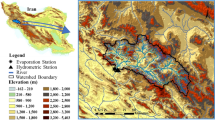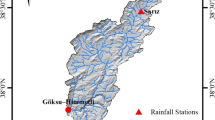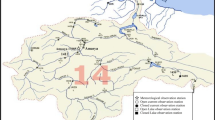Abstract
Improving predicting methods for streamflow series is an important task for the water resource planning, management, and agriculture process. This study demonstrates the development and effectiveness of a new hybrid model for streamflow predicting. In the present study, artificial neural networks (ANNs) coupled with wavelet transform, namely Additive Wavelet Transform (AWT), are proposed. Comparative analyses of Discrete wavelet transform (DWT) based ANN and conventional ANN techniques with the proposed method were presented. The analysis of these models was performed with monthly streamflow series for four stations on the Çoruh Basin, which is located in northeastern Turkey. The Bayesian regularization backpropagation training algorithm was employed for the optimization of the ANN network. The predicted results of the models were analyzed by the root mean square error (RMSE), Akaike information criterion (AIC), and coefficient of determination (R2). The obtained revealed that the proposed hybrid model represents significant accuracy compared to other models, and thus it can be a useful alternative approach for predicting studies.












Similar content being viewed by others
Data availability statement
All data used in this study are available from the web page (http://www.dsi.gov.tr/) of the General Directorate of State Hydraulic Works, Turkey (gauge numbers provided in the manuscript).
References
Abda Z, Chettih M, Zerouali B (2021) Assessment of neuro-fuzzy approach based different wavelet families for daily flow rates forecasting. Model Earth Syst Environ 7:1523–1538. https://doi.org/10.1007/s40808-020-00855-1
Adamowski J, Chan HF (2011) A wavelet neural network conjunction model for groundwater level forecasting. J Hydrol 407(1–4):28–40
Adamowski J, Sun KR (2010) Development of a coupled wavelet transform and neural network method for flow forecasting of non-perennial rivers in semi-arid watersheds. J Hydrol 390(1–2):85–91
Adamowski J, Chan HF, Prasher SO, Ozga-Zielinski B, Sliusarieva A (2012) Comparison of multiple linear and nonlinear regression, autoregressive integrated moving average, artificial neural network, and wavelet artificial neural network methods for urban water demand forecasting in Montreal, Canada. Water Resourc Res. https://doi.org/10.1029/2010WR009945
Akaike H (1981) Citation classic—a new look at the statistical-model identification. Curr Contents/eng Technol Appl Sci 51:22–22
Anders U, Korn O (1999) Model selection in neural networks. Neural Netw 12(2):309–323
Araghi A, Baygi MM, Adamowski J, Malard J, Nalley D, Hasheminia SM (2015) Using wavelet transforms to estimate surface temperature trends and dominant periodicities in Iran based on gridded reanalysis data. Atmos Res 155:52–72
Athar M, Ayaz M (2021) Application of ANN model to predict the sediment removal efficiency of silt extractor. Model Earth Syst Environ. https://doi.org/10.1007/s40808-021-01273-7
Belayneh A, Adamowski J, Khalil B, Ozga-Zielinski B (2014) Long-term SPI drought forecasting in the Awash River Basin in Ethiopia using wavelet neural network and wavelet support vector regression models. J Hydrol 508:418–429
Can I, Tosunoglu F, Kahya E (2012) Daily streamflow modelling using autoregressive moving average and artificial neural networks models: case study of Coruh basin, Turkey. Water Env J 26(4):567–576
Cannas B, Fanni A, See L, Sias G (2006) Data preprocessing for river flow forecasting using neural networks: wavelet transforms and data partitioning. Phys Chem Earth 31(18):1164–1171
Cigizoglu HK (2003) Estimation, forecasting and extrapolation of river flows by artificial neural networks. Hydrol Sci J 48(3):349–361
Cigizoglu HK (2004) Estimation and forecasting of daily suspended sediment data by multi-layer perceptrons. Adv Water Resour 27(2):185–195
Dalkiliç HY, Hashimi SA (2020) Prediction of daily streamflow using artificial neural networks (ANNs), wavelet neural networks (WNNs), and adaptive neuro-fuzzy inference system (ANFIS) models. Water Supply 20:1396–1408
Danandeh Mehr A, Kahya E, Olyaie E (2013) Streamflow prediction using linear genetic programming in comparison with a neuro-wavelet technique. J Hydrol 505:240–249
Freire PKDMM, Santos CAG, Silva GBLD (2019) Analysis of the use of discrete wavelet transforms coupled with ANN for short-term streamflow forecasting. Appl Soft Comput J 80:494–505
Güneş MŞ, Parim C, Yıldız D, Büyüklü AH (2021) Predicting monthly streamflow using a hybrid wavelet neural network: case study of the Çoruh River Basin. Pol J Environ Stud 30(4):3065–3075
Honorato AGDM, Da Silva GBL, CaG S (2018) Monthly streamflow forecasting using neuro-wavelet techniques and input analysis. Hydrol Sci J 63(15–16):2060–2075
Hsu KL, Gupta HV, Sorooshian S (1995) Artificial neural-network modeling of the rainfall-runoff process. Water Resour Res 31(10):2517–2530
Joshi N, Gupta D, Suryavanshi S, Adamowski J, Madramootoo CA (2016) Analysis of trends and dominant periodicities in drought variables in India: a wavelet transform based approach. Atmos Res 182:200–220
Kisi O (2005) Suspended sediment estimation using neuro-fuzzy and neural network approaches. Hydrol Sci J 50(4):683–696
Kisi O (2008) Stream flow forecasting using neuro-wavelet techniqu. Hydrol Process 22(20):4142–4152
Kisi O (2009) Neural networks and wavelet conjunction model for intermittent streamflow forecasting. J Hydrol Eng 14(8):773–782
Kohonen T (1988) An introduction to neural computing. Neural Netw 1(1):3–16
Kumar ARS, Sudheer KP, Jain SK, Agarwal PK (2005) Rainfall-runoff modelling using artificial neural networks: comparison of network types. Hydrol Process 19(6):1277–1291
Mallat SG (1989) A theory for multiresolution signal decomposition—the wavelet representation. IEEE Trans Pattern Anal Mach Intell 11(7):674–693
Mehr AD, Kahya E, Bagheri F, Deliktas E (2014) Successive-station monthly streamflow prediction using neuro-wavelet technique. Earth Sci Inf 7(4):217–229
Nalley D, Adamowski J, Khalil B (2012) Using discrete wavelet transforms to analyze trends in streamflow and precipitation in Quebec and Ontario (1954–2008). J Hydrol 475:204–228
Nalley D, Adamowski J, Khalil B, Ozga-Zielinski B (2013) Trend detection in surface air temperature in Ontario and Quebec, Canada during 1967–2006 using the discrete wavelet transform". Atmos Res 132:375–398
Nourani V, Mogaddam AA, Nadiri AO (2008) An ANN-based model for spatiotemporal groundwater level forecasting. Hydrol Process 22(26):5054–5066
Nourani V, Komasi M, Mano A (2009) A Multivariate ANN-wavelet approach for rainfall-runoff modeling. Water Resour Manage 23(14):2877–2894
Nourani V, Baghanam AH, Adamowski J, Kisi O (2014) Applications of hybrid wavelet-Artificial Intelligence models in hydrology: a review. J Hydrol 517:1189–1189
Nunez J et al (1999) Multiresolution-based image fusion with additive wavelet decomposition. IEEE Trans Geosci Remote Sens 37(3):1204–1211
Otazu X, Gonzalez-Audicana M, Fors O, Nunez J (2005) Introduction of sensor spectral response into image fusion methods application to wavelet-based methods. IEEE Trans Geosci Rem Sens 43(10):2376–2385
Partal T (2009) Modelling evapotranspiration using discrete wavelet transform and neural networks. Hydrol Process 23(25):3545–3555
Partal T, Cigizoglu HK (2008) Estimation and forecasting of daily suspended sediment data using wavelet-neural networks. J Hydrol 358(3–4):317–331
Partal T, Kisi O (2007) Wavelet and neuro-fuzzy conjunction model for precipitation forecasting. J Hydrol 342(1–2):199–212
Partal T, Kucuk M (2006) Long-term trend analysis using discrete wavelet components of annual precipitations measurements in Marmara region (Turkey). Phys Chem Earth 31(18):1189–1200
Rajendra P, Murthy KVN, Subbarao A, Boadh R (2019) Use of ANN models in the prediction of meteorological data. Model Earth Syst Environ 5:1051–1058
Salas JD, Delleur JW, Yevjevich V, Lane WL (1980) Applied modeling of hydrologic time serie. Water resource. Publ Littleton, Colorado
Salas JD, Markus M, Tokar AS (2000) Streamflow forecasting based on artificial neural networks. In: Govindaraju RS, Rao AR (eds) Artificial neural networks in hydrology. Springer, Dordrecht
Saraiva SV, Carvalho FDO, Santos CAG, Barreto LC, Freire PKDMM (2021) Daily streamflow forecasting in Sobradinho Reservoir using machine learning models coupled with wavelet transform and bootstrapping. Appl Soft Comput J 102:1568–4946. https://doi.org/10.1016/j.asoc.2021.107081
Sharie M, Mosavi MR, Rahemi N (2020) Determination of an appropriate mother wavelet for de-noising of weak GPS correlation signals based on similarity measurements. Eng Sci Technol Int J 23:281–288
Shiri J, Kisi O (2010) Short-term and long-term streamflow forecasting using a wavelet and nero-fuzzy conjunction model. J Hydrol 394:486–493
Siddiqi TA, Ashraf S, Khan SA, Iqbal MJ (2021) Estimation of data-driven streamflow predicting models using machine learning methods. Arab J Geosci 14:1058
Sithara S, Pramada SK, Thampi SG (2020) Sea level prediction using climatic variables: a comparative study of SVM and hybrid wavelet SVM approaches. Acta Geophys 68:1779–1790
Sume V, Mete B, Ozener AY (2017) Energy potential and environmental interaction of water structures in Upper Coruh Basin. Turk J Hydraul 1(1):7–12
Sun Y, Niu J, Sivakumar B (2019) A comparative study of models for short-term streamflow forecasting with emphasis on wavelet-based approach. Stoch Env Res Risk Assess 33:1875–1891
Taylor KE (2001) Summarizing multiple aspects of model performance in a single diagram. J Geophys Res Atmos 106(7):7183–7192
Torrence C, Compo GP (1998) A practical guide to wavelet analysis. Bull Am Meteor Soc 79(1):61–78
Tosunoglu F, Kaplan NH (2018) Determination of trends and dominant modes in 7-day annual minimum flows: additive wavelet transform-based approach. J Hydrol Eng 23:12
Unes F, Demirci M, Kisi O (2015) Prediction of millers ferry dam reservoir level in USA using artificial neural network. Period Polytechn Civ Eng 59(3):309–318
Vonesch C, Blu T, Unser M (2007) Generalized daubechies wavelet families. IEEE Trans Signal Process 55(9):4415–4429
Wang W, Ding J (2003) Wavelet network model and its application to the prediction of hydrology. Wavelet Netw Model Appl Predict Hydrol 1:1
Wu CL, Chau KW, Li YS (2009) Predicting monthly streamflow using data-driven models coupled with data-preprocessing techniques. Water Resourc Res 2009:45
Yilmaz M, Tosunoglu F, Kaplan NH (2020) Evaluation of trends and dominant modes in maximum flows in turkey using discrete and additive wavelet transforms. J Hydrol Eng 25:11
Acknowledgements
The authors sincerely thank the General Directorate of State Hydraulic Works, Turkey for the providing the streamflow data used in the study.
Author information
Authors and Affiliations
Corresponding author
Ethics declarations
Conflict of interest
On behalf of all authors, the corresponding author states that there is no conflict of interest.
Additional information
Publisher's Note
Springer Nature remains neutral with regard to jurisdictional claims in published maps and institutional affiliations.
Rights and permissions
About this article
Cite this article
Yilmaz, M., Tosunoğlu, F., Kaplan, N.H. et al. Predicting monthly streamflow using artificial neural networks and wavelet neural networks models. Model. Earth Syst. Environ. 8, 5547–5563 (2022). https://doi.org/10.1007/s40808-022-01403-9
Received:
Accepted:
Published:
Issue Date:
DOI: https://doi.org/10.1007/s40808-022-01403-9




